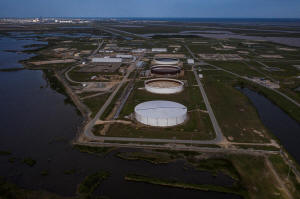Oil prices steady as solid U.S.crude demand offsets rate concerns
 Send a link to a friend
Send a link to a friend
 [May 30, 2024] By
Paul Carsten [May 30, 2024] By
Paul Carsten
LONDON (Reuters) -Oil prices were broadly steady as pressure from U.S.
data pointing to higher-for-longer rates was offset by inventory numbers
showing strong demand for crude in the United States.
Ahead of U.S. crude oil stockpiles data due later in the day, Brent
futures dipped 17 cents or 0.2% to $83.43 a barrel as of 0921 GMT, while
U.S. West Texas Intermediate (WTI) crude fell 12 cents or 0.15% to
$79.11.
Both benchmarks are headed for monthly losses, with Brent futures on
track for a decline of more than 5% from last month, while WTI was
poised for a slide of over 3%.
"The broader risk-off environment has translated to some downward
pressures on oil prices, which overrides the larger-than-expected
drawdown in U.S. crude inventories from the recent API data," said Yeap
Jun Rong, market strategist at IG.
U.S. crude oil inventories fell last week, down 6.49 million barrels
against analyst projections of a 1.9 million barrel draw, according to
market sources citing American Petroleum Institute figures on Wednesday.

Data from the U.S. Energy Information Administration (EIA) is due later
on Thursday.
But global oil inventories rose throughout April due to soft fuel
demand, which may strengthen the case for OPEC+ producers, which include
the Organization of the Petroleum Exporting Countries (OPEC) and allies
including Russia, to keep supply cuts in place when they meet on June 2,
OPEC+ delegates and analysts say.
"A greater driver for oil prices ahead may revolve around the upcoming
OPEC+ meeting this weekend, which could see OPEC members extending their
current production cuts potentially till the end of the third quarter to
support prices," Yeap added.
[to top of second column] |

The Bryan Mound Strategic Petroleum Reserve, an oil storage
facility, is seen in this aerial photograph over Freeport, Texas,
U.S., April 27, 2020. REUTERS/Adrees Latif/File Photo

Oil markets have been under pressure over expectations the Federal
Reserve will keep interest rates higher for longer, with Brent
settling at its lowest in more than three months on May 23.
U.S. economic activity continued to expand from early April through
mid-May but firms grew more pessimistic about the future while
inflation increased at a modest pace, a Fed survey showed.
Higher borrowing costs tend to tie down funds and consumption, a
negative for crude demand and prices. The Fed is now seen cutting
rates in September at the earliest, compared to a June start that
had been expected by markets at the beginning of the year.
Investors are also keeping an eye on key inflation data, with the
U.S. personal consumption expenditures index -- the Fed's preferred
measure of inflation -- and euro zone consumer prices due on Friday.
(Reporting by Paul Carsten in London, Katya Golubkova in Tokyo and
Jeslyn Lerh in Singapore; Editing by Shri Navaratnam, Edwina Gibbs
and Ana Nicolaci da Costa)
[© 2024 Thomson Reuters. All rights
reserved.]
This material may not be published,
broadcast, rewritten or redistributed.
Thompson Reuters is solely responsible for this content.
 |